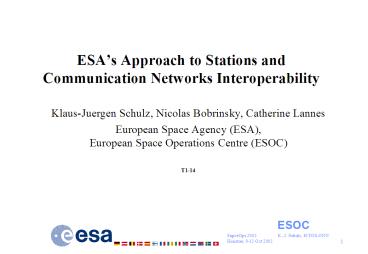ESAs Approach to Stations and Communication Networks Interoperability - PowerPoint PPT Presentation
1 / 19
Title:
ESAs Approach to Stations and Communication Networks Interoperability
Description:
Kourou (French Guiana) KRU. Malindi (Kenia) MAL. Maspalomas (Spain) MAS. New ... Network: Kiruna (Sweden), Kourou (French Guiana), Maspalomas (Spain), New ... – PowerPoint PPT presentation
Number of Views:89
Avg rating:3.0/5.0
Title: ESAs Approach to Stations and Communication Networks Interoperability
1
ESAs Approach to Stations and Communication
Networks Interoperability
- Klaus-Juergen Schulz, Nicolas Bobrinsky,
Catherine Lannes - European Space Agency (ESA), European Space
Operations Centre (ESOC) - T1-14
2
ESAs Stations Network
3
Mission Categories
- Deep Space missions (DS)
- Near-Earth missions, ranging from Geostationary
Transfer Orbit (GTO) to Lagrange type orbits - Low Earth Orbit (LEO) missions
- Frequency Bands S, X, Ku and Ka
4
Stations Overview
Kourou (French Guiana) KRU
Maspalomas (Spain) MAS
Redu (Belgium) RED-1
Villafranca (Spain) VIL-1
Transportable Vilspa (Spain) TS-1
Villafranca (Spain) VIL-2
Kiruna (Sweden) KIR-1
Kiruna (Sweden) KIR-2
Malindi (Kenia) MAL
New Norcia (Australia) NNO
Perth (Australia) PER
Santiago (Chile) AGO
PLUS 5 Baseband installations at Spacecraft
Checkout locations Gateway to Svalbard (TSS) sta
tions Gateway to NASA JPL DSN stations, to NASA
JPL Control Centre in preparation
Gateway to NASA GFCC Control Centre
Gateway to NASDA stations in preparation, to
NASDA Control Centre Gateway to CNES stations, t
o CNES Control Centre
Svalbard (Norway) SVA
5
Station Network Model
- Technical and Operational autonomy combined with
Economical Viability - ESA Core Stations Network Kiruna (Sweden),
Kourou (French Guiana), Maspalomas (Spain), New
Norcia (Western Australia), Perth (Western
Australia), Redu (Belgium) and Villafranca
(Spain) - ESA Augmented Network Malindi (Kenya), Santiago
(Chile), Svalbard (Norway) - ESA Cooperative Network CNES, NASA/DSN,
NASA/GSFC, NASDA, Prioranet
6
Interoperability Architecture
- Services
- Telemetry in online mode during the pass, and in
offline mode after the pass - Telecommand
- Orbit Determination based on Ranging, Doppler and
Antenna Angular measurements - Antenna Steering based on orbit information
- Voice Conferencing for Service and Operations
Coordination - Interoperability Solutions
- Interoperability by Hardware Deployment
- Interoperability using Bilateral Interface
Agreements - Interoperability using SLE Services
7
Interoperability by Hardware Deployment
- User agency equipment at Provider station
- Interface of User equipment to Provider antenna
front end at intermediate frequency - Communication system of the User agency
- Advantage
- No interface adaptation to Mission Control
System - Provider agency station looks like a User agency
station to the Mission Control System - Disadvantage
- Large effort for transportation, hosting,
installation, maintenance and operations
training, de-installation after a LEOP support
8
Interoperability using Bilateral Interface
Agreements
- Specific Interface by definition of a Wire
Protocol - Development of Gateway applications
- Advantage
- Cost and time effective
- Definition, Review, Implementation, Validation
effort not to be under-estimated - Disadvantage
- Multiplication of gateway solutions - Software
maintenance difficult - One gateway per pair of User and Provider agency
- Typical NM number of interfaces
9
Bilateral Interface Examples (ESAProvider)
NASCOM Gateway use for GOES-L LEOP
10
Bilateral Interface Examples (ESAProvider)
CNES Passerelle use for HISPASAT-1D
11
Bilateral Interface Examples (ESAProvider)NCTRS
use for ADEOS-2 LEOP and USERS Re-entry
12
Bilateral Interface Examples (ESAUser)CNES
Passerelle use for ENVISAT LEOP
13
Interoperability using SLE Services
- CCSDS Space Link Extension (SLE) Transfer
Services - Telemetry Return all Frame (RAF) and Return
Channel Frame (RCF) - Telecommand Command Link Transmission Unit
(CLTU) - Antenna Steering CCSDS standard for Orbit Data
Messages under negotiation - Orbit Determination CCSDS standard for Orbit
Data Messages under negotiation - Voice Coordination No CCSDS standard
- Technical interfaces based on common practise
analog audio interfaces - Operational interfaces based on common practise
voice procedures
14
SLE ESA Implementation Approach
- SLE User capability in common Mission Control
System software (NCTRS), used for MSG-1,
INTEGRAL, ROSETTA, Mars Express - SLE Provider capability deployment
- Enhanced COTS TM/TC equipment (InSnec/Cortex)
with local SLE gateway software, used on TS-1 for
MSG-1 (Jun 2002) - Central SLE Gateway for access to all ESA
stations (Nov 2002) - Native SLE TM/TC equipment in all ESA stations
(2003-2004) - SLE Management
- Simple Service Instance Configuration Management
(SICM) tool available - CCSDS SLE Management standard draft to be
drastically simplified before standardisation and
implementation
15
SLE Example (ESAUser)INTEGRAL / ROSETTA
Routine Support
16
SLE Example (ESAProvider)Future NASA-JPL Mars
Mission Support
17
Communication Network Interoperability
18
Cross Support Project Work Flow (ESA as Service
Provider for LEOP)
- Contract including Mission Implementation
Requirement Document (MIRD) and responded to in a
Mission Implementation Plan (MIP) - Cost-to-Completion, Quality Assurance plan, Task
distribution - Radio Frequency Compatibility Test
(space-ground-ICD) - New gateway development or re-use
- Network Configuration Document (NCD)
- Tailoring of configuration procedures for MC
systems - Ground Segment technical validation
- Network Operations Plan (NOP)
- Mission Readiness Tests (MRTs), System
Performance Tests (SPTs) - Tracking Campaigns, Simulation Campaigns, Final
Dress Rehearsal - LEOP Operation
- Lessons Learnt, Review of Cost at Completion
19
Conclusion
- 35 years of experience with cross support
scenario - Hardware deployment - Bilateral Interface
agreements - CCSDS Space Link Extension
standards / implementation - SLE Usage MSG-1 (28 Aug 02), INTEGRAL (17 Oct
02), ROSETTA (13 Jan 03), MARS Express (23 May
03), NASA Mars Missions (03) - SLE Deployment Plan based on staged approach
- SLE User capability, 2001
- SLE provider gateway (COTS enhancement) for one
station (TS-1), Jul 2002 - SLE central provider gateway for all ESTRACK
Stations, Nov 2002 - SLE native provider system in all ESTRACK
Stations, 2003-2004 - Standardised Cross Support Workflow
- Next steps standardised SLE Management Services
and Flight Dynamics Services































